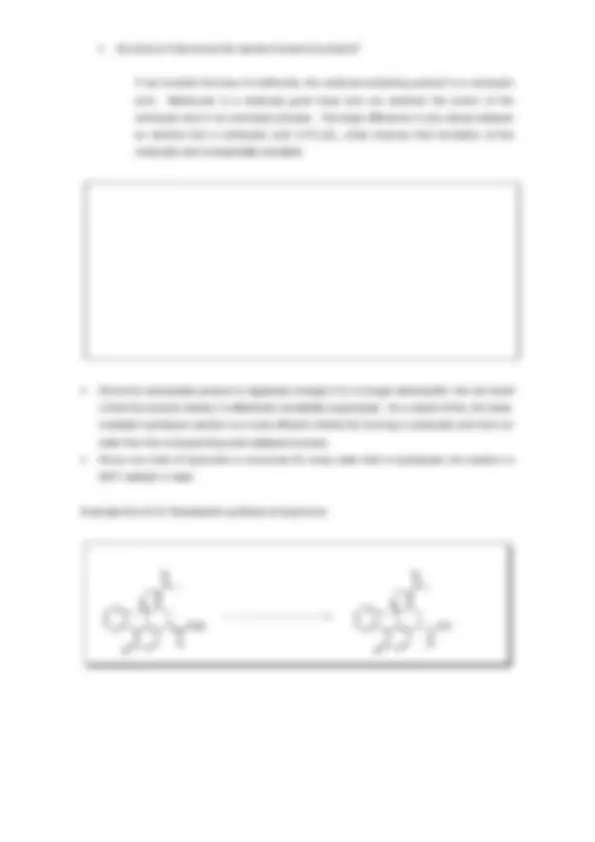








Study with the several resources on Docsity

Earn points by helping other students or get them with a premium plan


Prepare for your exams
Study with the several resources on Docsity

Earn points to download
Earn points by helping other students or get them with a premium plan
Community
Ask the community for help and clear up your study doubts
Discover the best universities in your country according to Docsity users
Free resources
Download our free guides on studying techniques, anxiety management strategies, and thesis advice from Docsity tutors
An in-depth exploration of the hydrolysis reactions of esters and amides, covering the mechanisms under acidic and basic conditions, the role of catalysts, and the formation of new esters through transesterification. Students will gain a comprehensive understanding of these reactions, including the reasons for the irreversibility of hydrolysis under basic conditions and the unique mechanisms for tert-butyl esters and amides.
What you will learn
Typology: Lecture notes
1 / 10

This page cannot be seen from the preview
Don't miss anything!







By the end of this lecture you will be able to:
Introduction
We have seen that carboxylic acid derivatives usually react through nucleophilic addition- elimination mechanisms. The parent carboxylic acid can be obtained from all its derivatives by this mechanism through a hydrolysis process. We shall just consider the mechanism of hydrolysis of esters and amides although similar reaction pathways are followed with other carboxylic acid derivatives.
Hydrolysis of Methyl Esters
Unlike acid chlorides, which are strong electrophiles and react readily with mild nucleophiles such as water, esters are much less electrophilic and do not react with water at pH 7 to any appreciable extent. However, the rate of ester hydrolysis can be substantially increased by carrying out the reaction under acidic or basic conditions.
Acid-Catalysed Hydrolysis of Methyl Esters
Since water is such a poor nucleophile, one method for increasing the rate of nucleophilic addition with an ester is to increase the electrophilicity of the ester. This can be achieved in a number of ways. The most common is to use a Lewis acid or Brønsted acid to form a positively charged intermediate that is far more reactive and with which even mild nucleophiles such as water will react.
Notes:
Base-Mediated Hydrolysis of Methyl Esters
An alternative method for increasing the rate of ester hydrolysis is to increase the reactivity of the nucleophile. Negatively charged species are generally more nucleophilic than electronically neutral species (they are also more basic). On these grounds hydroxide should be, and is, a better nucleophile than water.
Mechanism
Notes :
If we consider the loss of methoxide, the carbonyl-containing product is a carboxylic acid. Methoxide is a relatively good base and can abstract the proton of the carboxylic acid in an acid-base process. The large difference in p K (^) a values between an alcohol and a carboxylic acid (>10 p K (^) a units) ensures that ionisation of the carboxylic acid is essentially complete:
Example from R. B. Woodward's synthesis of strychnine:
N O O
OMe
N
O
N O O
OH
N
O
Hydrolysis of Amides
Owing to resonance stabilisation effects, amides are one of the least electrophilic carboxylic acid derivatives. Hydrolysis of an amide to the carboxylic acid therefore requires quite forcing reaction conditions.
Acid-Mediated Hydrolysis of Amides.
This reaction mechanism closely resembles the acid-catalysed hydrolysis of methyl esters. Proton transfer steps again increase the electrophilicity of the amide carbonyl group, and also generate a better leaving group (an amine instead of an amide):
Although protonation on an amide can conceivably occur either on the oxygen or on the nitrogen centre, in reality it always occurs on oxygen: unusually oxygen is more basic than nitrogen. This observation can be readily rationalised by considering the relative stability of the two protonated species:
Summary
Esters and amides are two of the least reactive carboxylic acid derivatives. Both groups benefit from a resonance stabilisation effect that is lost when a nucleophile attacks to form a tetrahedral intermediate. The greater is the resonance stabilisation, the lower is the energy of the starting material and therefore the larger is the barrier to forming the tetrahedral intermediate (usually rate-determining). This accounts for the observation that amides are less electrophilic than esters.
Nevertheless both esters and amides can be hydrolysed to the parent carboxylic acid. Reaction is very sluggish at pH7; however by using acidic conditions to increase the electrophilicity of the carbonyl centre, or using a base to generate a more reactive nucleophile (hydroxide), the hydrolysis can be made to proceed at reasonable rates.
The precise mechanism of acid-catalysed hydrolysis of esters depends on the structure of the alkyl group in the ester. A mechanism involving cleavage of the acyl−oxygen bond is most common and is observed for all simple esters. tert- Butyl esters, however, react through a different mechanism involving scission of the alkyl−oxygen bond in the rate-determining step.
Acid-catalysed hydrolysis reactions are reversible. The forward reaction is driven over to product by using an excess of water, usually as the solvent. Base-mediated hydrolyses, however are essentially irreversible because the product is a non-electrophilic carboxylate salt.
Transesterification reactions proceed via similar mechanisms and are also catalysed by either acid or base.
Protonation of amides occurs on oxygen and not on nitrogen.